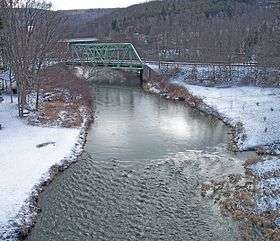Casselman River
The Casselman River is a 56.5-mile-long (90.9 km)[1] tributary of the Youghiogheny River in western Maryland and Pennsylvania in the United States.[2] The Casselman River drains an area of 576 square miles.[3]

The Casselman River rises in Garrett County atop the plateau of western Maryland as two branches, the south one east of Meadow Mountain, the north one farther west, between Meadow Mountain and Negro Mountain. The two branches flow northward, combining just southwest of Grantsville, Maryland. The river then continues north into Pennsylvania, following a great arc across the Laurel Highlands of Somerset County, Pennsylvania, to the community of Confluence, where Laurel Hill Creek joins a few meters above the Youghiogheny River.[2][4] Between Grantsville, Maryland, and Confluence, Pennsylvania, the Casselman River flows by the following communities: West Salisbury, Boynton, Meyersdale, Garrett, Rockwood, Casselman, Markleton, and Fort Hill.
The river has been used for transportation across the Allegheny Mountains, between the cities of Baltimore and Washington, D.C. in the east and Pittsburgh in the west. Two railroads followed the Casselman River from Meyersdale, Pennsylvania to Confluence. First is the B&O Railroad, running between Baltimore and Pittsburgh, which was completed in 1827, and is currently owned by CSX. Second is the Western Maryland Railway, which ran from Cumberland, Maryland to Connellsville, Pennsylvania. Although the Western Maryland was abandoned in the 1980s, the right-of-way has been converted into the Great Allegheny Passage, a rail trail bicycle and hiking path.[5]
References
- U.S. Geological Survey. National Hydrography Dataset high-resolution flowline data. The National Map Archived 2012-04-05 at WebCite, accessed August 15, 2011
- Gertler, Edward. Keystone Canoeing, Seneca Press, 2004. ISBN 0-9749692-0-6
- Survey Report: Youghiogheny River Watershed: Program for Runoff and Waterflow Retardation and Soil Erosion Prevention. Washington, DC: U.S. Dept. of Agriculture. 1951. p. 1 of App. A. Retrieved June 17, 2020.
- "The River." Casselman River Watershed Association. Web. 09 June 2012. <http://www.casselmanriver.org/the-river> Archived September 2, 2012, at the Wayback Machine.
- "A Brief History of the Trail." Great Allegheny Passage. Allegheny Trail Alliance. Web. 09 June 2012. <http://www.atatrail.org/au/page4.cfm Archived 2013-03-27 at the Wayback Machine>.